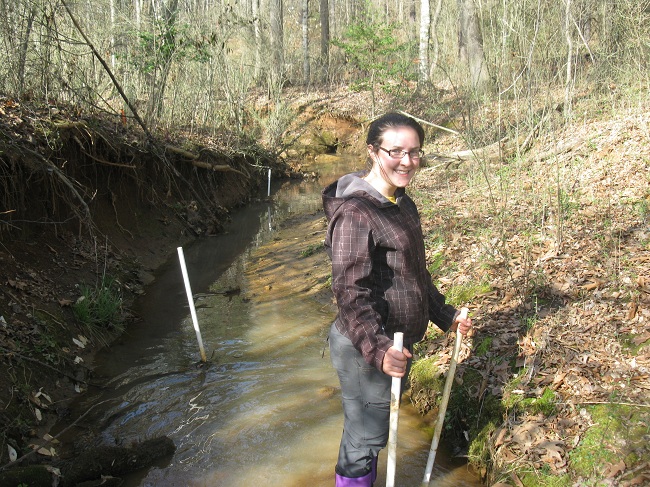Mackenzie Osypian defends her thesis on stream restoration and transient storage
Mackenzie Osypian is defending her MS research in Civil Engineering at UNC Charlotte, April 22nd at 4:00 pm in McEniry Hall 441 on the UNC Charlotte campus. Mackenzie is advised by Anne Jefferson and Sandra Clinton. John Daniels and Jim Bowen are on her committee.
Mackenzie’s research is titled: “Evaluating restoration effects on transient storage and hyporheic exchange in urban and forested streams.” Her abstract is below:
Millions of dollars are spent each year on restoration projects designed to improve stream habitat, but few studies have investigated effects of restoration on groundwater- surface water interactions. Hyporheic exchange and transient storage in four second-order streams (urban/forest; restored/unrestored) were studied by measuring geomorphology, streambed vertical head gradients and water fluxes, and by using conservative, impulse-loaded tracer studies along with the OTIS model. Total storage exchange and percent hyporheic exchange were found by utilizing the OTIS P parameters and the sum of downwelling fluxes calculated in SURFER. The upwelling and downwelling varied between -1.783 m/m to 3.760 m/m in the restored urban stream, which contains large step structures, while the unrestored urban stream had no measured upwelling or downwelling (0 m/m) along the reach, which is incised to bedrock. The forested restored stream had a smaller range of hydraulic gradients (-0.012 m/m to 1.99 m/m) compared to the forested unrestored stream, which ranged from -0.725 m/m to 0.610 m/m. The forested unrestored reach had the highest percent of hyporheic exchange, reaching 22% during the winter season. The urban restored has the smallest percent of hyporheic exchange of 0% across all seasons due to the exposure of bedrock in the streambed. The restored reaches were found to have between 0% and 6% of total transient storage exchange occurring in the hyporheic zones, with some seasonal variability.
The results indicate that restoration increases the hyporheic storage when the stream has incised to bedrock, but that large in-channel storage is also created. When the stream has an alluvial bed (as in the forested streams), the percent of hyporheic flow compared to total storage is reduced. The forested unrestored stream had the largest average hydraulic conductivity of 0.006 cm/s compared to the forested restored, 0.001 cm/s, and the urban restored, 0.001 cm/s. The restored forested site had a maximum area to storage area ratio of 247 m2/m2 in the spring, which was higher than the forested unrestored site. That site had a maximum of 16.4 m2/m2, which occurred during the fall season.
We are currently preparing her thesis for publication.

